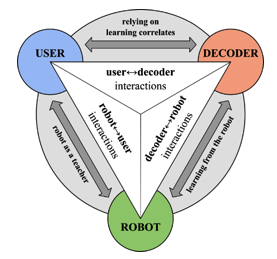BrainGear
Brain-machine interfaces 2.0: A threefold symbiotic learning entity

Brain-machine interfaces (BMIs) are systems able to translate human brain patterns into commands for robotic devices to restore the independence of users with severe motor disabilities. However, despite the flourishing of brain-actuated prototypes, after three decades of research, BMIs are still lacking practicable solutions for daily use by end-users and current research approaches that assume that BMI should be treated only as a decoder tool, have not been able to face this translational challenge.
BrainGear is two-year project, funded by the Department of Information Engineering of the Università degli Studi di Padova, that aims at radically departing the traditional approach by considering BMI as a multi-agent learning entity where the three actors involved—user, decoder, and robotic device—have to mutually learn from each other.
The objective of BrainGear is threefold:
1) To identify new neural correlates of user learning to make the BMI decoder follow and adapt to the user’s learning curve
2) To develop advanced shared-control algorithms that fuse the BMI decoder output and the robot intelligence to make the robot learn
3) To propose innovative interaction strategies where the robot acts as a teacher for the user’s training
The project will evaluate the existence of these learning interactions in an experimental scenario based on a brain-driven powered wheelchair.
BrainGear is led by Luca Tonin (This email address is being protected from spambots. You need JavaScript enabled to view it.) and it takes advantage from the multidisciplinary experience of the research group that harmoniously merges the expertise on brain-machine interfaces and advanced human-robot interactions of the IAS-Lab, the neurophysiological competence in clinical/physiological interpretation and in advanced EEG analysis of the NEUROMOVE-Rehab laboratory (Department of Neuroscience, Università degli Studi di Padova) and the know-how on mechanical design of rehabilitation devices of the Sports & Rehabilitation Engineering Lab (Department of Industrial Engineering, Università degli Studi di Padova).












